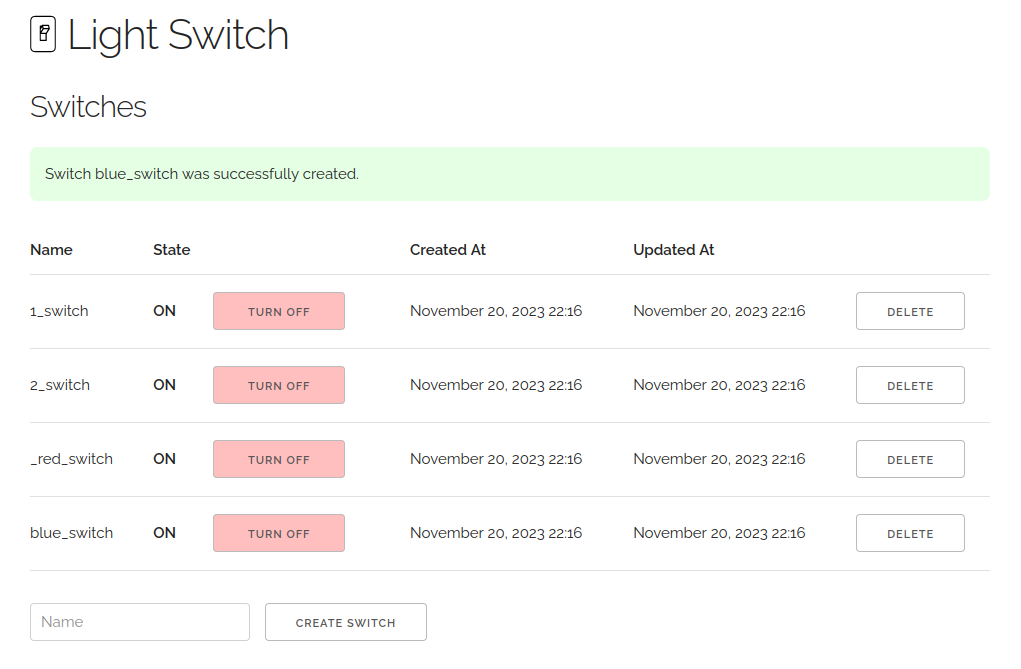Simple circuit breakers on Rails
LightSwitch aims to be a very simple circuit breaker implementation. You can
use a LightSwitch to turn things on and to turn things off. That's pretty much
it.
Stoplight and
Circuitbox are excellent, full-featured
circuit breaker libraries.
LightSwitch is much more basic. In particular, LightSwitch does not
dynamically respond and adjust to errors. As the operator of your application,
you are expected to manually turn switches off and on when you need to.
You may ask, "If I have turned off a particular piece of code, how do I know
when it's okay to turn it back on?" That's a great question but it's not one
that LightSwitch tries to answer for you. Stoplight and Circuitbox are
great at that sort of circuit breaking. Maybe you are monitoring a third-party's
status page. Maybe another team is fixing their service and will let you know
when the service is back up. Maybe you just turn your piece of code back on and
monitor things closely.
Some apps may not need the sophisticated, powerful behavior of Stoplight or
Circuitbox; some apps may not run their recommended infrastructure (e.g. Redis).
For simple cases where you are already running Rails, you may prefer the
simplicity of LightSwitch.
LightSwitch imitates Flipper when
it comes to its API. If you want to use Flipper for your circuit breaking
needs, go for it. Some teams prefer to reserve Flipper strictly for feature
flags. Some organizations expose the Flipper UI to a wide range of internal
users especially if Product Managers enable and disable features on behalf of
customers. You probably want to limit the exposure of your LightSwitches. You
would not want someone to turn off a piece of code unless they really knew what
they were doing. Lightswitch can give you a little separation between feature
flags and circuit breakers. Flipper is well-suited to do the job if you want
to use it, though.
A LightSwitch::Switch has two states, on and off. This gem's convention
is that an off switch will short circuit a given piece of code. Therefore
the recommended usage of LightSwitch is something like this:
def my_method
return if LightSwitch.off?(:my_switch)
do_stuff
endOr
def my_method
do_stuff if LightSwitch.on?(:my_switch)
endYou can interpret off and on however you want; it's up to you.
What few defaults LightSwitch implements assume the convention above, though.
If you have Rails console access, you can turn switches on and off:
LightSwitch[:my_switch].on! # turns the switch on
LightSwitch[:my_switch].off! # turns the switch offLightSwitch comes with a web UI that can be mounted in your rails application.
Just add the following to config/routes.rb:
Rails.application.routes.draw do
mount LightSwitch::Engine => "/light_switch"
endYou can limit access to the UI by using Rails routing constraints.
You most likely want to initialize all of your switches when your app boots up.
This ensures that the switches are present in the LightSwitch UI so that you
can easily manage them. If you forget to initialize a switch, LightSwitch will
assume that the switch is on so that your code guarded by a switch will run
(assuming you follow the conventions demonstrated above). You can initialize
your switches in a Rails initializer.
# config/initializers/light_switch.rb
LightSwitch.configure do |config|
config.switches = %i[
one_switch
two_switch
red_switch
blue_switch
]
endBy default, LightSwitch does not leverage caching, but you can configure
LightSwitch to use a cache if you have performance concerns. For example,
Rails.cache may be configured by setting LightSwitch.config.cache in a
Rails initializer:
# config/initializers/light_switch.rb
LightSwitch.configure do |config|
config.cache = Rails.cache
endYou should not use an in-memory cache for LightSwitch. LightSwitch
caches values indefinitely and will reset cached values whenever an
underlying LightSwitch::Switch model is changed. If you are using an
in-memory cache, LightSwitch has no way to clear the caches used by all of
the various processes running your application (web workers, Sidekiq workers, etc.).
If you are using a centralized cache, like Redis or MemCached, feel free to use
it with LightSwitch. The queries to read a switch from the database are
indexed and will return very quickly, so most LightSwitch users will not
need caching.
You can also implement your own cache as long as it implements the interface
of LightSwitch::NullCache.
If you wish to be notified of changes made to any switches, you can subscribe
to ActiveSupport::Notifications
published by LightSwitch. There are three events available:
create_committed.switch.light_switchdestroy_committed.switch.light_switchupdate_committed.switch.light_switch
An example use case could be logging changes for visibility:
# config/initializers/light_switch.rb
ActiveSupport::Notifications.subscribe("update_committed.switch.light_switch") do |*args|
event = ActiveSupport::Notifications::Event.new(*args)
switch = event.payload[:switch]
Rails.logger.info("#{switch.name} is now #{switch.state}")
endThe events captured do not capture any meaningful latency metrics. They are just
published events once changes to a LightSwitch::Switch are committed.
Add this line to your application's Gemfile:
gem "light_switch"And then execute:
$ bundle
$ ./bin/rails light_switch:install:migrations db:migrateOr install it yourself as:
$ gem install light_switchFork this repo and submit a pull request.
If you find a bug or have a feature request, please open a GitHub issue.
The gem is available as open source under the terms of the MIT License.
